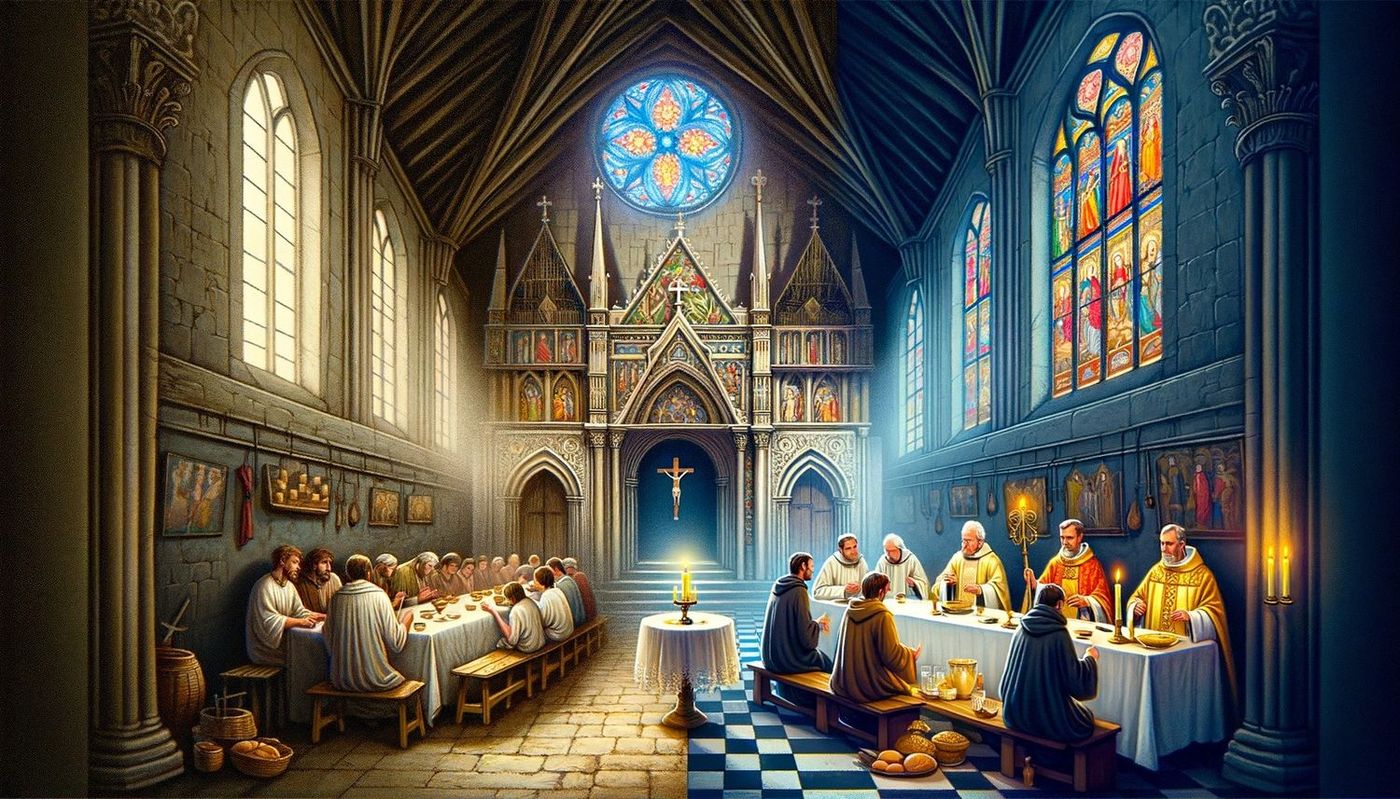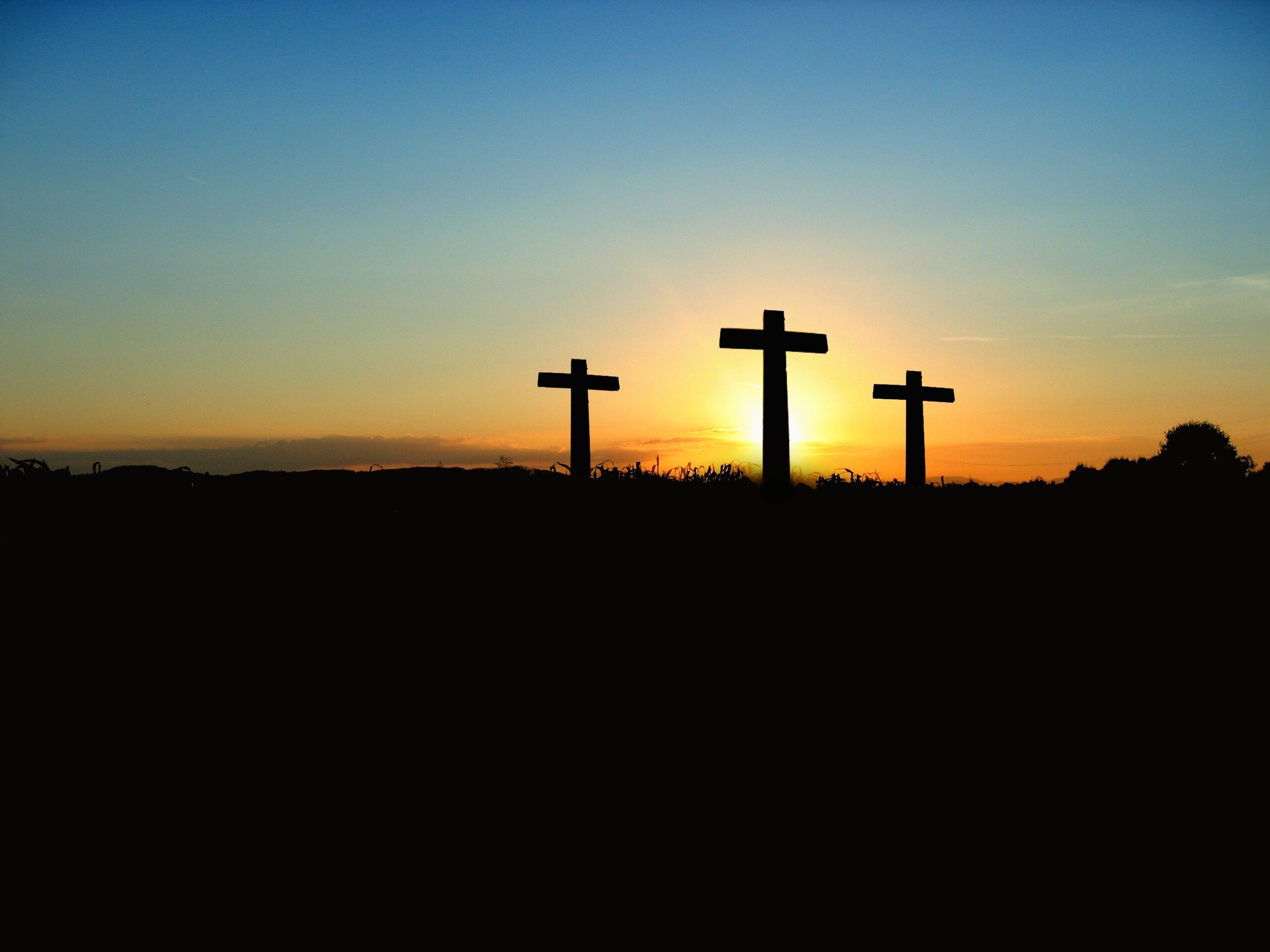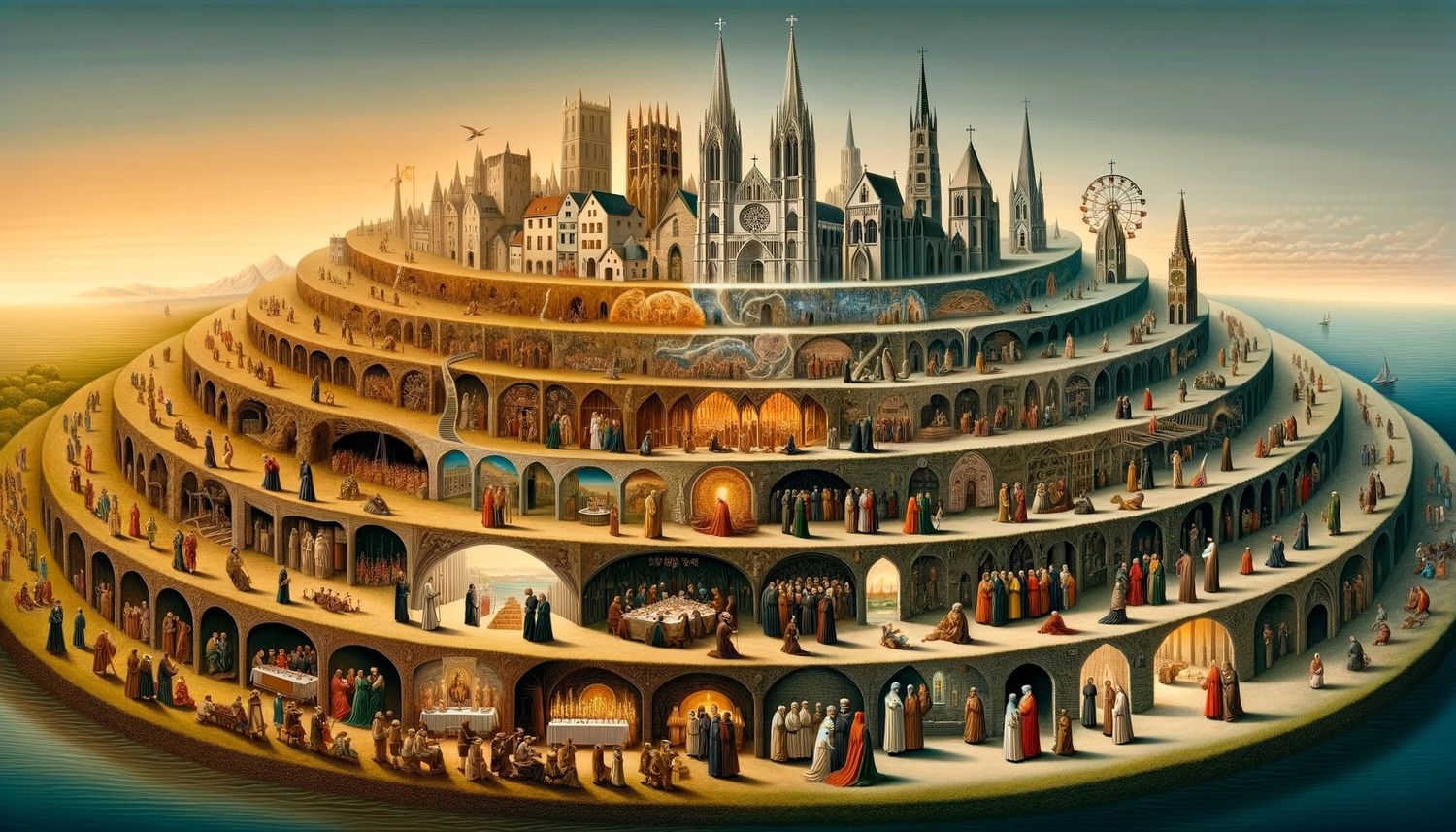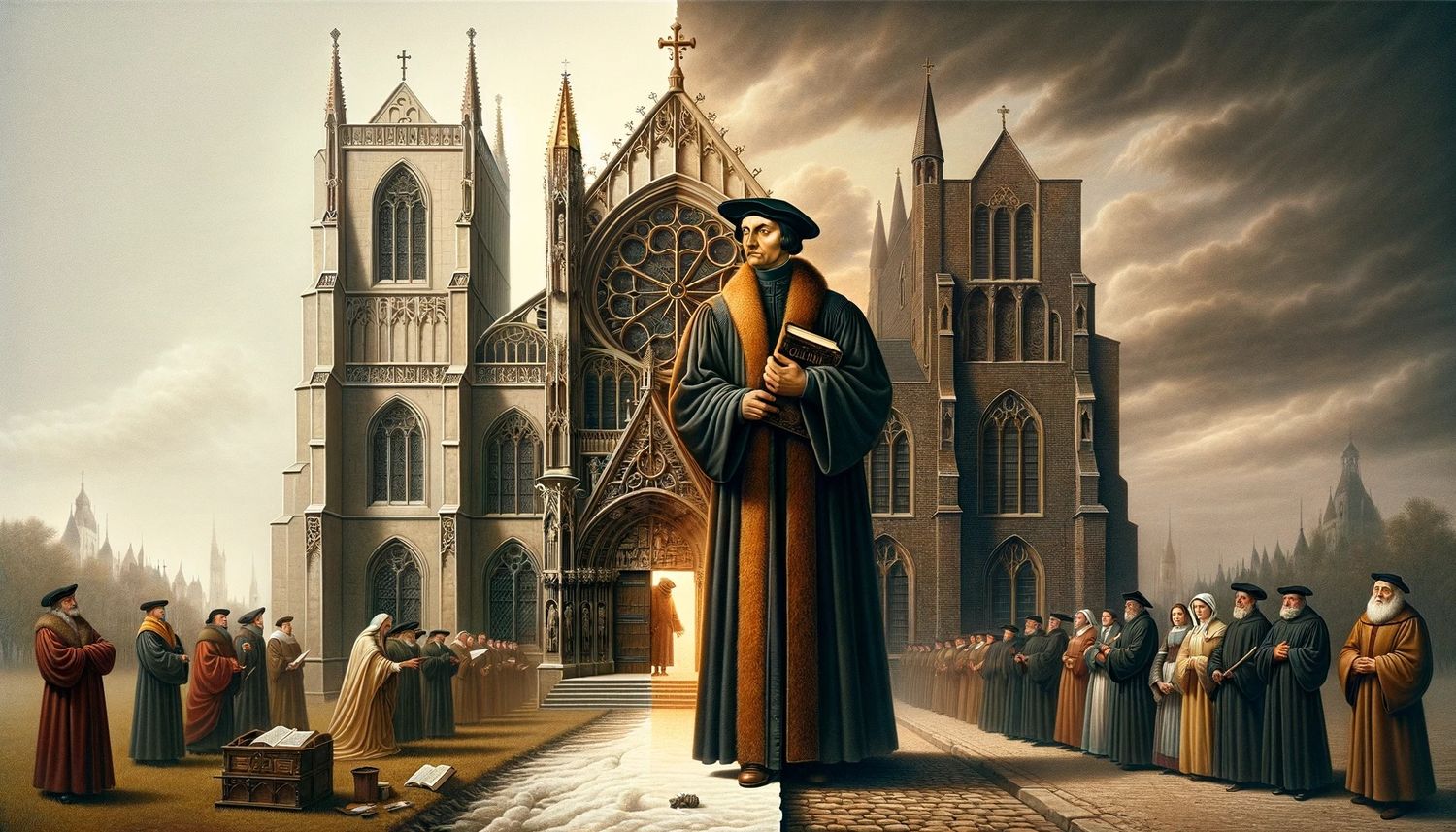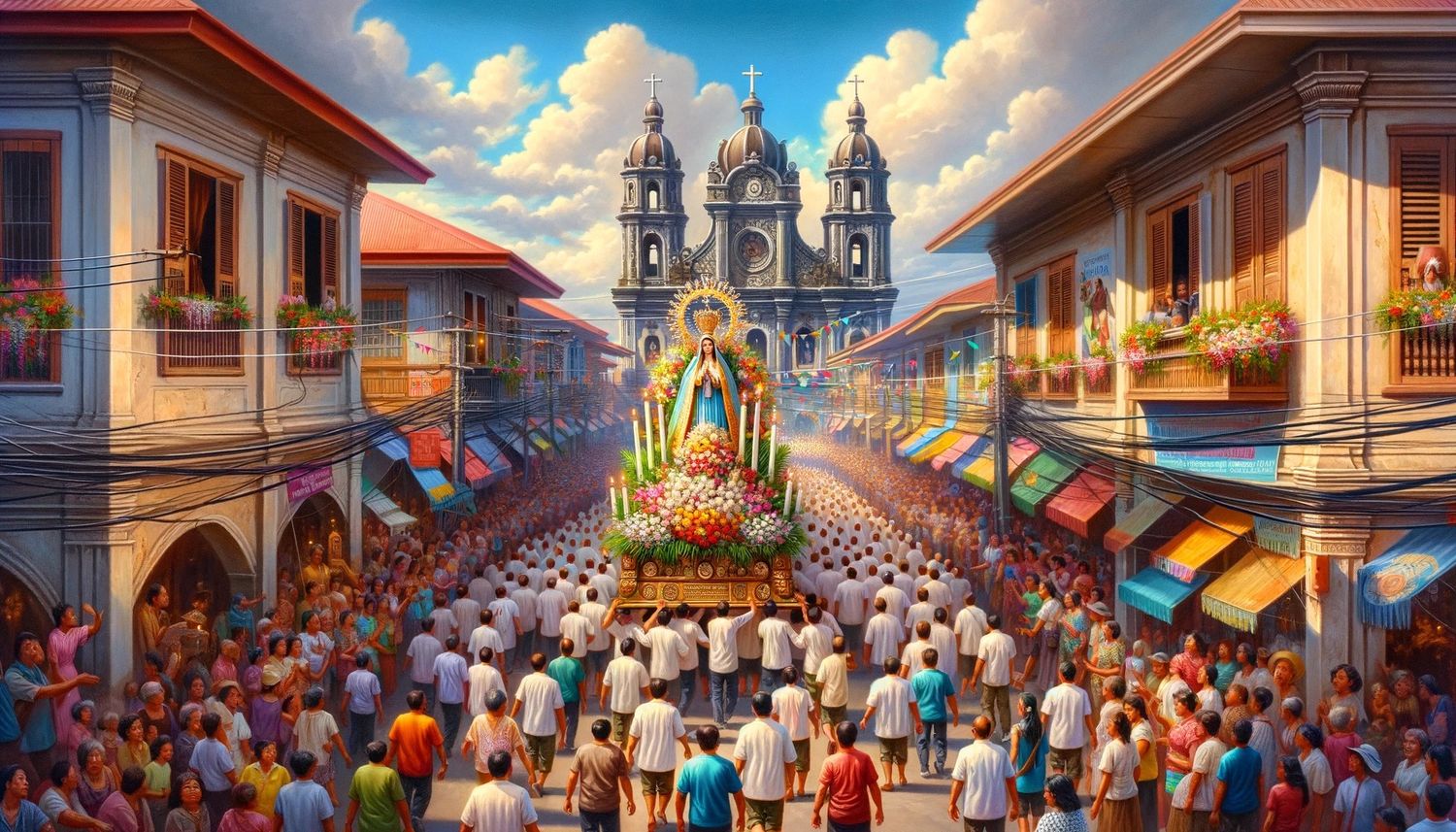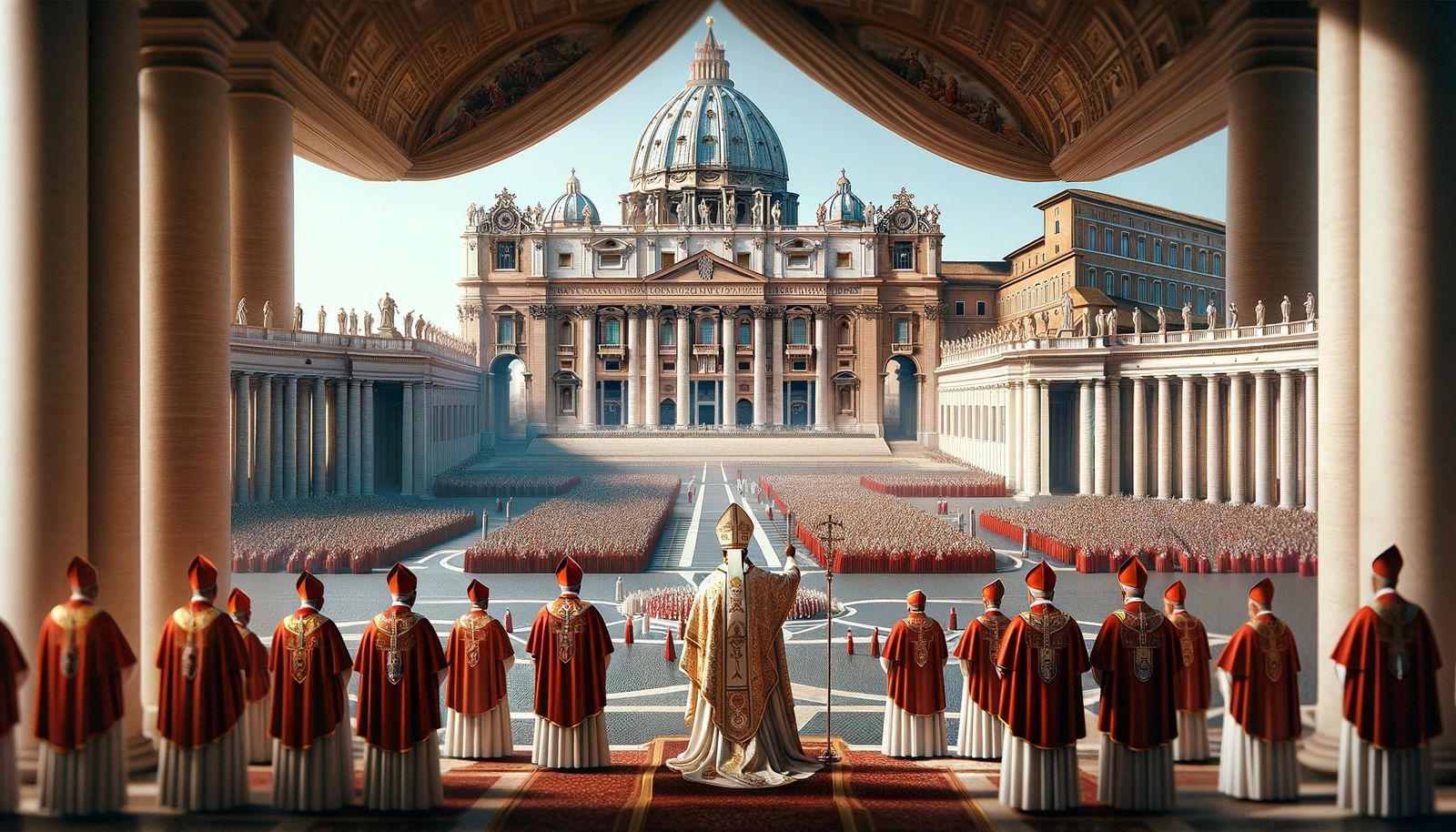Home>Theology and Spirituality>Which Religion Is Most Like Catholicism


Theology and Spirituality
Which Religion Is Most Like Catholicism
Published: February 18, 2024
Ericka Andersen, an editor at Christian.net, expertly merges digital strategy with content creation, focusing on faith and societal issues. Her communication skills enhance the platform's engaging narratives, fostering meaningful dialogue on belief's impact on society.
Discover which religion is most similar to Catholicism and explore theology and spirituality in this insightful comparison. Gain a deeper understanding of the connections and differences.
(Many of the links in this article redirect to a specific reviewed product. Your purchase of these products through affiliate links helps to generate commission for Christian.net, at no extra cost. Learn more)
Table of Contents
Introduction
Catholicism, with its rich history, traditions, and beliefs, holds a prominent place in the world of religion. Its influence extends across continents, shaping cultures and societies for centuries. As we explore the diverse landscape of religious beliefs, it's natural to wonder which other faiths share similarities with Catholicism. While each religion possesses unique characteristics, some exhibit parallels in certain aspects, fostering a deeper understanding of the interconnectedness of spiritual practices.
In this exploration, we will delve into various religious traditions, examining their doctrines, rituals, and overarching philosophies. By doing so, we aim to shed light on the resemblances and differences between Catholicism and other prominent faiths. This comparative analysis will not only unveil the common threads that bind these religions but also celebrate the diversity that enriches the tapestry of human spirituality. Let's embark on this enlightening journey to discover which religion resonates most closely with the tenets of Catholicism.
Christianity
Christianity, the world's largest religion, shares a common lineage with Catholicism, tracing its origins to the teachings of Jesus Christ. While Catholicism represents a significant branch of Christianity, several other denominations within the faith bear resemblances to its core beliefs and practices.
Eastern Orthodox
The Eastern Orthodox Church, with its intricate liturgical traditions and emphasis on sacraments, aligns closely with Catholicism. Both traditions venerate saints, honor the Virgin Mary, and uphold the authority of apostolic succession. The reverence for icons and the use of incense in worship further underscore the parallels between Eastern Orthodoxy and Catholicism.
Anglicanism
As a result of historical and theological ties, Anglicanism shares several fundamental aspects with Catholicism. The retention of many Catholic rituals, such as the Eucharist and the sacraments, reflects the close affinity between the two traditions. Additionally, the hierarchical structure of the Anglican Church, akin to the Catholic hierarchy, contributes to the similarities between these faiths.
Lutheranism
Lutheranism, stemming from the Protestant Reformation, maintains certain theological affinities with Catholicism. Both traditions emphasize the significance of scripture and the sacraments, particularly baptism and communion. While Lutheranism diverges from Catholicism on doctrinal matters such as justification by faith alone, the shared reverence for the Bible underscores their common Christian heritage.
Read more: Which Religions Have Communion
Methodism
Methodism, known for its emphasis on personal piety and social justice, shares common ground with Catholicism in its commitment to charitable works and outreach to marginalized communities. The Methodist focus on the sacraments and the concept of sanctification resonates with Catholic beliefs, fostering a sense of spiritual kinship between the two traditions.
Protestantism
Within the broader spectrum of Protestantism, certain denominations exhibit parallels with Catholicism in their liturgical practices and theological outlook. High Church Anglicanism and some Lutheran expressions maintain closer ties to Catholicism, embracing elements such as liturgical worship, sacramental theology, and episcopal polity.
In examining the diverse expressions of Christianity, it becomes evident that while each tradition possesses distinct theological nuances, many share common ground with Catholicism in their reverence for scripture, sacraments, and historical continuity. This interconnectedness underscores the profound influence of Catholicism on the broader Christian landscape, fostering a sense of unity amidst theological diversity.
Eastern Orthodox
The Eastern Orthodox Church, with its intricate liturgical traditions and emphasis on sacraments, aligns closely with Catholicism. Both traditions venerate saints, honor the Virgin Mary, and uphold the authority of apostolic succession. The reverence for icons and the use of incense in worship further underscore the parallels between Eastern Orthodoxy and Catholicism.
The Eastern Orthodox Church, also known as the Orthodox Catholic Church, shares a common history with Catholicism, tracing its roots to the early Christian Church. The theological and doctrinal similarities between the two traditions are striking, reflecting their shared heritage and foundational beliefs. The concept of the Holy Trinity, the divinity of Jesus Christ, and the belief in the sacraments as vehicles of divine grace form the cornerstone of both Eastern Orthodoxy and Catholicism.
One of the defining features of Eastern Orthodoxy is its rich liturgical worship, characterized by elaborate rituals and profound symbolism. The celebration of the Eucharist, or Divine Liturgy, holds central importance in Orthodox worship, mirroring the significance of the Mass in Catholic liturgical practice. The use of incense, the chanting of hymns, and the intricate iconography within Orthodox churches create a sensory-rich environment reminiscent of Catholic sacred spaces.
Furthermore, the veneration of saints and the emphasis on their intercessory role in the lives of believers are shared elements between Eastern Orthodoxy and Catholicism. Both traditions honor the Virgin Mary as the Theotokos, or Mother of God, underscoring her pivotal role in the salvation narrative. The veneration of icons, prevalent in Eastern Orthodox spirituality, echoes the reverence for religious imagery within Catholic devotional practices, emphasizing the visual representation of sacred figures and events.
A notable aspect that illustrates the affinity between Eastern Orthodoxy and Catholicism is the adherence to apostolic succession and the episcopal structure of church governance. The hierarchical organization of the clergy, the role of bishops as guardians of the faith, and the preservation of apostolic authority through the laying on of hands reflect the shared ecclesiastical framework that has endured since the early Christian era.
In essence, the parallels between Eastern Orthodoxy and Catholicism extend beyond theological doctrines to encompass the lived experience of faith within these traditions. The profound sense of reverence, the sacramental ethos, and the continuity with ancient Christian practices unite these two expressions of Christianity, fostering a profound spiritual kinship that transcends historical divisions.
Anglicanism
Anglicanism, a distinct branch of Christianity with a rich historical legacy, shares a complex relationship with Catholicism, characterized by both divergence and convergence in theological and liturgical practices. Emerging from the English Reformation, Anglicanism embodies a unique synthesis of Catholic tradition and Protestant principles, giving rise to a nuanced religious identity that resonates with elements of both traditions.
At its core, Anglicanism maintains a profound connection to Catholicism through its retention of many traditional rituals and sacramental practices. The celebration of the Eucharist, or Holy Communion, holds central significance within Anglican worship, mirroring the sacramental emphasis found in Catholic liturgical observance. The use of liturgical vestments, the reverence for the consecrated elements, and the ritualized nature of the Eucharistic service reflect the sacramental ethos shared between Anglicanism and Catholicism.
Furthermore, the hierarchical structure of the Anglican Church, characterized by the episcopal polity and the role of bishops as guardians of the faith, bears resemblance to the organizational framework of the Catholic Church. The emphasis on apostolic succession, the historical continuity of ordained ministry, and the recognition of the historic episcopate underscore the parallels between Anglicanism and Catholicism in matters of ecclesiastical governance and spiritual authority.
While Anglicanism embraces certain Catholic elements, it also diverges from Roman Catholic doctrine in significant ways, particularly in matters of papal authority, the veneration of saints, and the interpretation of certain theological tenets. The rejection of papal supremacy and the embrace of a national ecclesiastical identity distinguish Anglicanism from Catholicism, reflecting the historical and theological complexities that have shaped the Anglican tradition.
In essence, Anglicanism occupies a distinctive position within the broader Christian landscape, embodying a synthesis of Catholic heritage and Protestant principles. The interplay of shared sacramental practices, liturgical expressions, and historical ties underscores the intricate relationship between Anglicanism and Catholicism, illuminating the diverse tapestry of Christian faith and tradition.
Read more: Which Religion Practices Confession?
Lutheranism
Lutheranism, stemming from the Protestant Reformation, maintains certain theological affinities with Catholicism while also embracing distinct doctrinal perspectives. At the heart of Lutheranism lies a profound emphasis on the primacy of scripture and the doctrine of justification by faith, distinguishing it from certain aspects of Catholic theology.
One of the central theological pillars of Lutheranism is the concept of sola scriptura, which asserts the sole authority of the Bible in matters of faith and practice. This foundational principle, championed by Martin Luther during the Reformation, represents a departure from certain Catholic teachings on the role of tradition and ecclesiastical authority. Despite this doctrinal variance, Lutheranism shares with Catholicism a deep reverence for the scriptures, affirming the foundational role of the Bible in shaping Christian belief and conduct.
In the realm of sacramental theology, Lutheranism maintains a sacramental worldview akin to Catholicism, particularly in its understanding of baptism and the Eucharist. While Lutheranism diverges from Catholic doctrine on the concept of transubstantiation, it upholds the real presence of Christ in the Eucharistic elements, underscoring the sacramental continuity between these traditions. The significance of baptism as a means of grace and initiation into the Christian community further reflects the sacramental ethos shared by Lutheranism and Catholicism.
Moreover, Lutheranism's emphasis on the priesthood of all believers and the universal priesthood of baptized Christians resonates with certain aspects of Catholic theology, particularly in its recognition of the spiritual agency of the laity within the Church. This theological emphasis underscores the shared commitment to the priesthood of believers as a foundational aspect of Christian identity and vocation.
In essence, while Lutheranism and Catholicism diverge on certain doctrinal points, they also exhibit significant theological affinities, particularly in their shared reverence for scripture, sacramental worldview, and the priesthood of all believers. This nuanced interplay of theological convergence and divergence enriches the broader landscape of Christian faith, highlighting the diverse expressions of belief and practice within the Christian tradition.
Methodism
Methodism, a vibrant and influential Christian tradition, embodies a distinctive spiritual ethos that resonates with certain aspects of Catholicism while also embracing its own theological emphases. Founded by John Wesley and his brother Charles Wesley in 18th-century England, Methodism emerged as a movement characterized by its emphasis on personal piety, social outreach, and vibrant expressions of faith.
At the heart of Methodism lies the concept of sanctification, which emphasizes the transformative work of God's grace in the lives of believers. This emphasis on holiness and spiritual growth aligns with the Catholic emphasis on the pursuit of sanctity and the transformative power of divine grace. Methodism's focus on the pursuit of holiness and the inward transformation of the individual resonates with the Catholic emphasis on spiritual formation and the cultivation of a deep, personal relationship with God.
Furthermore, Methodism's commitment to social justice and charitable works reflects a shared concern with Catholic social teaching, which emphasizes the ethical imperative of addressing societal inequities and advocating for the dignity of every human person. The Methodist emphasis on alleviating poverty, advocating for the marginalized, and promoting societal transformation through acts of mercy and compassion mirrors the Catholic commitment to social justice and the promotion of the common good.
In matters of worship and sacramental practice, Methodism exhibits certain parallels with Catholicism, particularly in its celebration of the sacraments and the emphasis on corporate worship. The significance of the Eucharist as a means of grace and spiritual nourishment, along with the practice of baptism as a rite of initiation into the Christian community, underscores the sacramental ethos shared by Methodism and Catholicism. Additionally, the liturgical expressions within certain Methodist traditions, characterized by formalized worship and the use of liturgical vestments, reflect a sacramental sensibility akin to Catholic liturgical practice.
In essence, Methodism's emphasis on personal piety, social justice, and sacramental spirituality fosters a sense of spiritual kinship with Catholicism, illuminating the diverse expressions of Christian faith and practice. The interplay of shared values and theological emphases underscores the interconnectedness of these traditions, enriching the broader tapestry of Christian spirituality and witness in the world.
Protestantism
Protestantism, encompassing a diverse array of denominations and theological perspectives, represents a significant branch of Christianity that emerged from the 16th-century Reformation. The Protestant movement, sparked by reformers such as Martin Luther, John Calvin, and Huldrych Zwingli, sought to address perceived theological and institutional concerns within the Roman Catholic Church, leading to the proliferation of distinct Protestant traditions.
Within the broad spectrum of Protestantism, various denominations exhibit parallels with Catholicism in their liturgical practices and theological outlook. High Church Anglicanism and certain Lutheran expressions maintain closer ties to Catholicism, embracing elements such as liturgical worship, sacramental theology, and episcopal polity. The retention of traditional rituals, such as the celebration of the Eucharist and the recognition of the sacraments, reflects the sacramental ethos shared by these Protestant traditions and Catholicism.
Furthermore, certain Protestant denominations emphasize the importance of historical continuity and the preservation of ancient Christian practices, echoing the Catholic commitment to apostolic tradition and the historical roots of Christian faith. The recognition of the early church fathers, the appreciation for ancient creeds, and the incorporation of liturgical elements within worship underscore the shared reverence for historical continuity and the enduring legacy of Christian tradition.
While Protestantism encompasses a wide spectrum of theological perspectives, ranging from conservative to liberal interpretations, certain denominations within Protestantism exhibit a profound sense of spiritual kinship with Catholicism in their sacramental ethos, liturgical expressions, and historical consciousness. This interconnectedness underscores the enduring influence of Catholicism on the broader Christian landscape, fostering a sense of unity amidst theological diversity within the Protestant tradition.
In essence, the diverse expressions of Protestantism reflect a complex interplay of theological convergence and divergence with Catholicism, illuminating the intricate tapestry of Christian faith and practice. The shared sacramental ethos, historical consciousness, and liturgical expressions within certain Protestant traditions underscore the interconnectedness of these faith traditions, enriching the broader landscape of Christian spirituality and witness in the world.
Judaism
Judaism, one of the world's oldest monotheistic religions, holds a unique position within the broader religious tapestry, embodying a rich heritage of faith, tradition, and ethical teachings. As we explore the parallels between Judaism and Catholicism, it becomes evident that despite their distinct theological frameworks, these traditions share profound historical and spiritual connections.
At the core of Judaism lies a deep reverence for the Torah, the sacred scripture comprising the foundational teachings and narratives of the Jewish faith. This emphasis on the authority of scripture resonates with the Catholic reverence for the Bible as the inspired word of God, reflecting a shared commitment to the primacy of divine revelation in shaping religious belief and practice. The ethical precepts and moral imperatives articulated within the Torah and the broader Jewish tradition underscore the shared emphasis on ethical living and the pursuit of righteousness, fostering a sense of moral kinship between Judaism and Catholicism.
Furthermore, both Judaism and Catholicism uphold the significance of ritual observance and communal worship as integral aspects of religious life. The rich tapestry of Jewish rituals, encompassing practices such as Shabbat observance, holiday celebrations, and lifecycle events, reflects a profound commitment to the sanctification of time and the cultivation of sacred communal experiences. Similarly, Catholic liturgical practices, including the celebration of the Mass, sacramental rites, and liturgical seasons, underscore the sacramental ethos and the communal dimension of worship within the Catholic tradition. This shared emphasis on ritual observance and communal worship underscores the interconnectedness of Jewish and Catholic spiritual practices, fostering a sense of shared religious experience.
Moreover, the profound sense of historical continuity and the preservation of ancient traditions within Judaism and Catholicism highlight the enduring legacy of faith and the interconnectedness of religious heritage. The recognition of sacred history, the commemoration of key events, and the preservation of ancestral customs underscore the shared commitment to historical consciousness and the transmission of religious legacy across generations.
In essence, while Judaism and Catholicism embody distinct theological perspectives and historical trajectories, the shared reverence for scripture, the emphasis on ritual observance, and the commitment to historical continuity underscore the profound spiritual connections between these traditions. This exploration illuminates the diverse expressions of faith and tradition, fostering a deeper appreciation for the interconnectedness of religious heritage and the enduring dialogue between Judaism and Catholicism.
Islam
Islam, a global faith with over a billion adherents, holds a profound place within the religious landscape, embodying a rich tapestry of spiritual beliefs, ethical principles, and cultural expressions. As we explore the parallels between Islam and Catholicism, it becomes evident that despite their distinct theological frameworks, these traditions share profound historical and spiritual connections.
At the heart of Islam lies the Quran, the central religious text believed to be the verbatim word of God as revealed to the Prophet Muhammad. This emphasis on the authority of scripture resonates with the Catholic reverence for the Bible as the inspired word of God, reflecting a shared commitment to the primacy of divine revelation in shaping religious belief and practice. The ethical precepts and moral imperatives articulated within the Quran and the broader Islamic tradition underscore the shared emphasis on ethical living and the pursuit of righteousness, fostering a sense of moral kinship between Islam and Catholicism.
Furthermore, both Islam and Catholicism uphold the significance of ritual observance and communal worship as integral aspects of religious life. The five pillars of Islam, encompassing practices such as the declaration of faith, prayer, fasting, almsgiving, and pilgrimage, reflect a profound commitment to the sanctification of time and the cultivation of sacred communal experiences. Similarly, Catholic liturgical practices, including the celebration of the Mass, sacramental rites, and liturgical seasons, underscore the sacramental ethos and the communal dimension of worship within the Catholic tradition. This shared emphasis on ritual observance and communal worship underscores the interconnectedness of Islamic and Catholic spiritual practices, fostering a sense of shared religious experience.
Moreover, the profound sense of historical continuity and the preservation of ancient traditions within Islam and Catholicism highlight the enduring legacy of faith and the interconnectedness of religious heritage. The recognition of sacred history, the commemoration of key events, and the preservation of ancestral customs underscore the shared commitment to historical consciousness and the transmission of religious legacy across generations.
In essence, while Islam and Catholicism embody distinct theological perspectives and historical trajectories, the shared reverence for scripture, the emphasis on ritual observance, and the commitment to historical continuity underscore the profound spiritual connections between these traditions. This exploration illuminates the diverse expressions of faith and tradition, fostering a deeper appreciation for the interconnectedness of religious heritage and the enduring dialogue between Islam and Catholicism.
Buddhism
Buddhism, a profound and ancient tradition originating from the teachings of Siddhartha Gautama, known as the Buddha, encompasses a diverse array of philosophical insights, ethical principles, and contemplative practices. As we explore the parallels between Buddhism and Catholicism, it becomes evident that despite their distinct theological frameworks, these traditions share profound historical and spiritual connections.
At the core of Buddhism lies the Four Noble Truths and the Eightfold Path, which serve as foundational principles guiding the pursuit of enlightenment and liberation from suffering. The ethical precepts and moral imperatives articulated within these foundational teachings underscore the shared emphasis on ethical living and the pursuit of spiritual awakening, fostering a sense of moral kinship between Buddhism and Catholicism.
Furthermore, both Buddhism and Catholicism uphold the significance of ritual observance and communal worship as integral aspects of religious life. The rich tapestry of Buddhist rituals, encompassing practices such as meditation, chanting, and ceremonial offerings, reflects a profound commitment to the cultivation of inner peace and the communal experience of spiritual transformation. Similarly, Catholic liturgical practices, including the celebration of the Mass, sacramental rites, and communal prayer, underscore the sacramental ethos and the communal dimension of worship within the Catholic tradition. This shared emphasis on ritual observance and communal worship underscores the interconnectedness of Buddhist and Catholic spiritual practices, fostering a sense of shared religious experience.
Moreover, the profound sense of historical continuity and the preservation of ancient traditions within Buddhism and Catholicism highlight the enduring legacy of faith and the interconnectedness of religious heritage. The recognition of sacred history, the commemoration of key events, and the preservation of ancestral customs underscore the shared commitment to historical consciousness and the transmission of religious legacy across generations.
In essence, while Buddhism and Catholicism embody distinct theological perspectives and historical trajectories, the shared emphasis on ethical living, ritual observance, and historical continuity underscores the profound spiritual connections between these traditions. This exploration illuminates the diverse expressions of faith and tradition, fostering a deeper appreciation for the interconnectedness of religious heritage and the enduring dialogue between Buddhism and Catholicism.
Hinduism
Hinduism, often regarded as the world's oldest living religion, encompasses a diverse tapestry of spiritual beliefs, philosophical insights, and cultural practices. As we delve into the parallels between Hinduism and Catholicism, it becomes evident that despite their distinct theological frameworks, these traditions share profound historical and spiritual connections.
At the heart of Hinduism lies the concept of dharma, which encompasses the ethical and moral duties that guide an individual's conduct and responsibilities within society. This emphasis on ethical living and the pursuit of righteousness resonates with the Catholic emphasis on moral virtues and the ethical imperatives articulated within Catholic social teaching. The shared commitment to ethical conduct and the cultivation of virtuous living fosters a sense of moral kinship between Hinduism and Catholicism.
Furthermore, both Hinduism and Catholicism uphold the significance of ritual observance and communal worship as integral aspects of religious life. The rich tapestry of Hindu rituals, encompassing practices such as puja (worship), yajna (sacrificial offerings), and festive celebrations, reflects a profound commitment to the sanctification of time and the communal experience of spiritual devotion. Similarly, Catholic liturgical practices, including the celebration of the Mass, sacramental rites, and communal prayer, underscore the sacramental ethos and the communal dimension of worship within the Catholic tradition. This shared emphasis on ritual observance and communal worship underscores the interconnectedness of Hindu and Catholic spiritual practices, fostering a sense of shared religious experience.
Moreover, the profound sense of historical continuity and the preservation of ancient traditions within Hinduism and Catholicism highlight the enduring legacy of faith and the interconnectedness of religious heritage. The recognition of sacred history, the commemoration of key events, and the preservation of ancestral customs underscore the shared commitment to historical consciousness and the transmission of religious legacy across generations.
In essence, while Hinduism and Catholicism embody distinct theological perspectives and historical trajectories, the shared emphasis on ethical living, ritual observance, and historical continuity underscores the profound spiritual connections between these traditions. This exploration illuminates the diverse expressions of faith and tradition, fostering a deeper appreciation for the interconnectedness of religious heritage and the enduring dialogue between Hinduism and Catholicism.
Conclusion
In conclusion, the exploration of the parallels between Catholicism and various religious traditions reveals a tapestry of interconnectedness and shared spiritual values that transcend theological differences. While each tradition maintains its distinct theological framework and historical trajectory, the overarching themes of ethical living, ritual observance, and historical continuity serve as unifying threads that bind these diverse faiths together.
The profound reverence for scripture, whether in the form of the Bible, the Quran, the Torah, or the sacred texts of Hinduism and Buddhism, underscores the shared commitment to divine revelation and the ethical imperatives that guide human conduct. This emphasis on ethical living, moral virtues, and the pursuit of righteousness fosters a sense of moral kinship among these traditions, highlighting the universal human quest for spiritual fulfillment and ethical integrity.
Furthermore, the significance of ritual observance and communal worship within these traditions reflects a deep yearning for spiritual connection and the sanctification of communal experiences. Whether through the celebration of the Eucharist, the practice of meditation, or the observance of religious festivals, these traditions emphasize the transformative power of communal worship and the cultivation of sacred time and space.
The commitment to historical continuity and the preservation of ancient traditions underscores the enduring legacy of faith and the interconnectedness of religious heritage. The recognition of sacred history, the commemoration of key events, and the transmission of religious legacy across generations highlight the shared commitment to preserving the spiritual wisdom and cultural heritage embedded within these traditions.
In essence, the exploration of the parallels between Catholicism and other religious traditions illuminates the interconnectedness of human spirituality and the enduring dialogue between diverse faiths. This enriching journey fosters a deeper appreciation for the diverse expressions of faith and tradition, fostering a spirit of mutual respect, understanding, and dialogue within the global tapestry of religious diversity.


